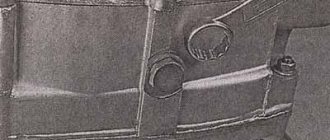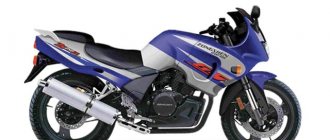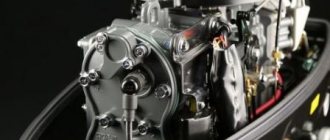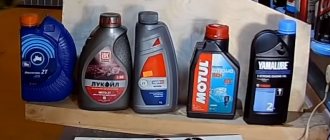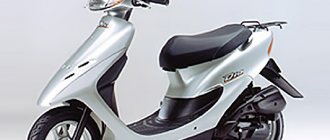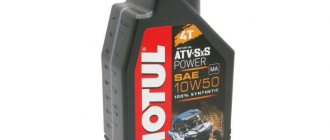Gearbox oil
The instructions say what kind of oil should be poured into the engine, but there is not a word about the gearbox. Although we are all accustomed to the fact that transmission oil is poured into the box, usually thicker than in the engine.
Owners of Alpha mopeds (and the like) need to know that the gearbox, engine and clutch are located in the same (common) crankcase and are lubricated with the same oil . This way you don’t have to think about what kind of oil needs to be poured and where. It is one!
Front fork
I was thinking about changing the oil in the front fork on an Alfa, I looked on the Internet and found how much to pour (in the Alfa 120 ml, in the Delta 160 ml (in each leg)), but I couldn’t find any exact criteria about what kind of oil to pour there. Questions: Have you changed the oil in the fork? Which one did you fill and how many ml? At what mileage did you decide to change the oil?
Added after 5 minutes
I’m also thinking about replacing the front drum brake with a disc brake, but since there is no mount for a caliper on the fork legs, I’m thinking of installing a complete fork or just the legs from Parton King 50. But I don’t know the size of the fork from King and whether it will fit into the Alpha yokes
There, as far as I know, the oil is not changed but topped up as needed. They suggested oil to me and 20. spindle in common parlance.
Added after 2 minutes
I’m also thinking about replacing the front drum brake with a disc brake, but since there is no fastening for a caliper on the fork legs, I’m thinking of installing a complete fork or just the legs from Parton King 50. But I don’t know the size of the King fork and whether it will fit into the Alpha crossbars [/ quote]
Take and measure the diameters of the pipes with a rod of both. And compare. But there is no reason to install a disk drive on 50 cubic meters. And then decide for yourself.
I changed it and barely opened the feathers. Clamped in a vice in a barbaric manner, removed the decor on the fork and clamped it in it. So I opened it. I temporarily filled it with 10w40, at least better than the original oil. I poured it to the edge in clamped fork. (This might be correct, but it’s temporary)
Oil for four-stroke engines
This phrase means that you cannot fill a moped engine with two-stroke oil. The thing is that two-stroke engines have a completely different principle of engine lubrication: they mix oil with gasoline in certain proportions (either in a gas tank or using a special oil pump), and then, together with gasoline, first enter the engine crankcase, lubricating the bearings crankshaft and connecting rod, as well as the cylinder mirror. The mixture then enters the combustion chamber, where the oil burns along with gasoline and is discharged from the engine through the exhaust pipe. Thus, two-stroke oil is not designed for long-term use , it is “disposable”.
In most four-stroke engines (and the Alpha's engine is four-stroke), oil is poured into the engine crankcase and lubricates the rubbing parts either by splashing (due to the rotating parts of the engine) or under pressure (which is created by the oil pump). Oil also helps cool the engine. Therefore, the oil in a four-stroke engine must withstand long service life at high temperatures.
Some owners ask: “Do I need to add oil to gasoline?” Remember: for Alpha mopeds (Delta, Sabur, Vento, etc.) there is no need to add oil to gasoline!
What happens during break-in?
During the first hundreds of kilometers, the following happens:
- The chain stretches to working length (sometimes even more).
- Bolted connections loosen under vibration.
- Gaskets take the shape of the cavities in which they are placed.
- All excess lubricants (oils) burn out.
- The cables stretch, causing play to appear at the steering arms.
- All contacting parts are ground in.
- The engine and transmission are reaching operating parameters.
All this has a beneficial effect, but only if the running-in is carried out correctly.
API classification
API is a quality classification system for automobile oils. The oil designation in this system consists of Latin letters.
The first part can be either S (Service) - oil for gasoline engines, C (Commercial) - oil for diesel engines, EC (Energy Conserving) - energy-saving oils.
The next letter is the designation of the oil generation. The designation is in alphabetical order, i.e. The farther the letter is from the beginning of the Latin alphabet, the higher the generation of oil (better performance qualities).
API categories SA, SB, SC, SD, SE, SF, SG are currently recognized as invalid, category SH is considered conditionally valid. Thus, oil of the SE and SF cannot be found on sale now. What kind of oil should you buy then? The answer is to buy any one that is further down the alphabet (SJ, SL, SM, SN), it will in any case be no worse than the recommended one.
Start of renovation
Before starting repairs, place the motorcycle on a comfortable and reliable stand, so that the front wheel is free. Next you will need to remove the wheel and disconnect it from the brake mechanism. In some cases, it is also necessary to remove the wing or rudder.
You should start by “undermining” the plugs of the feathers. Not by unscrewing, but by changing the position of the cover by a quarter turn. Corks are always made with decorative processing or chrome plated. If you don’t have a reliable and clearly sized key on hand, you shouldn’t injure the plugs.
A slight slippage or licking of the edges will immediately ruin the attractive appearance. Some craftsmen use fabric or thin rubber as a gasket. This method cannot prevent the appearance of scratches, even if you try very hard.
A closed plug will not only protect the cylinders from dirt, but will also prevent injury from a fired, tense steel spring. After loosening the traverse bolts, you need to smoothly remove the fork. Before this procedure, you should have a container prepared to remove used oil from the fork. Turn the fork over and drain the oil from the feathers. Judging by the color and consistency, it becomes clear why the fork was cottony or too hard.
SAE classification
The latest edition of the classification divides motor oils into 11 classes: 6 winter (0W, 5W, 10W, 15W, 20W, 25W) and 5 summer (20, 30, 40, 50, 60) viscosity classes. The letter W (Winter) before the number means that the oil is adapted to work at low temperatures.
Most motor oils on the market today are all-season, that is, they meet viscosity requirements at both low and high temperatures and have a double designation, for example in our case: SAE 15W-40 . The first number characterizes the pumpability of the oil at low temperatures. If you subtract 35 from the first digit, you get the minimum temperature at which a safe cold start of the engine is possible. The second number is an indicator of oil viscosity at 100 degrees Celsius. If you add 5 to the second digit, you get the maximum permissible air temperature at which the oil can be used.
Marking and viscosity
Engine wear is affected by the oil viscosity parameter
. The required viscosity depends on the operating temperature of the engine and is usually specified in the operating instructions. The generally accepted standard for designating viscosity according to the American SAE method: 5W40, 5W30, 10W40, 10W50 or simply SAE 40, SAE 50. Moreover, the first number indicates the viscosity of the oil in a cold engine, the second - in one warmed up to operating temperature. The letter W indicates that the oil belongs to winter or all-season varieties. Summer varieties do not have this letter and the first number (SAE 30, SAE 40). The lower the first number, the better the engine starts in cold weather. But if there is no need to ride a moped in winter, there is no point in using liquid oil. In warm weather, high viscosity provides better lubrication of power unit parts, the oil film on rubbing surfaces is not destroyed, and dry friction, overheating and destruction of parts are prevented.
For summer, viscosity 10W40, 10W50, SAE 30, SAE 40, etc. is more suitable. The higher the viscosity of the oil when hot (second number), the better suited the oil is for hot operating conditions. In mid-latitudes, SAE 30 or SAE 40 is quite suitable. In hot countries, SAE 50 and even SAE 60 are used.
Return to contents
Synthetic, semi-synthetic or mineral water?
It is generally accepted that synthetic oils are of the highest quality and almost extend the life of the engine. On the other hand, as I wrote above, now any oil that has been certified according to the API standard is suitable for use in the Alpha moped engine.
I chose the golden mean for myself: I pour semi-synthetics from imported manufacturers into my moped, because... the price of a liter of semi-synthetic oil is now not much different from the price of mineral oil.
But only now you can rarely find semi-synthetic 15W-40 on store shelves. Mostly mineral oils are sold with this designation. Therefore, I fill the engine with 10W-40 oil as the closest to the manufacturer’s recommendations.
Responsible process
The controllability of the motorcycle, and, consequently, the safety of the driver and others depends on the correct selection of oil for the fork. It is best to follow the recommendations of the motorcycle manufacturer, but increase the viscosity of the technical fluid when components wear in order to achieve good damping characteristics. It is also worth paying attention to the oil change procedure - the ability to adjust the suspension and obtain optimal rigidity depends on its correct implementation. We must not forget about flushing the fork after draining the old oil - drops of technical fluid remaining inside and chips obtained from friction between the components can significantly affect the characteristics of the shock absorbers. If you are not sure that you can perform an oil change and suspension adjustment yourself, contact professional mechanics, since your interventions can only cause harm.
What kind of oil to pour into the engine of an Alpha moped. :
Thank you very much, I read all your articles and more and study them. In October 2021 I’m taking an alpha like 110, with a mileage of about 3 thousand km for 12 thousand rubles. At a friend's place. I am 28 years old, this will be my first motor. Previously it was 21099, I changed the clutch myself and cleaned, washed and adjusted the entire carbure. But I sold it because I didn’t drive it. Previously, I studied to become an auto mechanic, by the way, with honors... But for 10 years I haven’t even read a single article about internal combustion engines and automoto... I have gone very far from automoto... I FORGOT EVERYTHING... And nostalgia has taken over. But still, having experience, albeit long-standing and theoretical, having ridden the alpha and studied it, I realized that the moped is affordable and normal for the money. And with proper care, it will please you. I decided to take it. At the same time, I’ll ask something about my future moped in your corresponding thread... I’ll wait for an answer. My name is Pasha.
Tell me, if the mileage on a moped is 70 km, and a year has passed, should the oil be changed?
I did not find any direct instructions in the instructions about changing the oil on time. And in theory it should be enough for 500 km. running-in. But oil loses its properties over time, and no one knows what kind of oil was originally poured. Therefore, to be sure, you can change the oil, especially since a liter of semi-synthetic now costs about 300 rubles.
If on the canister you filled it it is written that the expiration date is 1 year, then yes it is necessary.))))) If not. Then roll on some more kilometers...)
The fact of the matter is that there is no canister; with a mileage of 70 km, the oil must be filled in from the factory (or from the store where the moped was assembled). And what was poured there, and how long ago it was poured, no one knows. Of course, the oil lasts much longer than a year, but if in doubt, it’s easier to replace it and forget about it. Moreover, the replacement price is about 300 rubles + 30 minutes of time spent. Although I don’t think that if you don’t replace it, something terrible will happen in the 430 km remaining before replacement.
The oil needs to be changed anyway! The oil, even when not in use, comes into contact with air and therefore oxidizes. The shelf life of motor oil in sealed packaging is 5 years. If oil is used, as in our case, then it must be changed every year.
I'm sure I work with oils, chemicals, and car cosmetics. I know about polyalphaolefin oils, hydrocracking, and other crap. No nail or rod for everyone!
Yes. If the equipment is not used for a long time, the oil loses its properties.
Please tell me I have a semi-automatic transmission and am interested in what kind of oil to pour into it if the engines are already filled with 10w40
Most likely you have a semi-automatic clutch, that is, there is no clutch lever on the steering wheel. The box is almost the same. That is, oil is not poured into it separately.
A lot of questions and disputes arise about which oil is suitable for the Alpha moped or for small Chinese motorcycles, for example Stealth Delta 200, Racer Magnum 200 and the like. Therefore, it is worth understanding how oils differ and why some of them are not suitable for your Chinese motorcycle.
To begin with, you should immediately clarify that the term “motor oil” is not in any of the motorcycle operating instructions. You can check your Alpha manual - there is no word “motor oil” there. There are only specifications that the oil being poured and its characteristics must meet.
Oil is divided into three large groups: - mineral: - semi-synthetic; - synthetic.
The engines of the Alpha moped were copied from the Japanese Honda Super Cub. Do you know when it started being produced in Japan? The first sample rolled off the assembly line in 1958, that is, more than 50 years ago. In those days, little was known about semi-synthetic or synthetic, even in Japan; then there was only one oil - mineral. Therefore, your moped engines are not demanding on oil quality.
How often to change
Scheduled maintenance is divided into three steps. They should adhere to different replacement intervals.
- The first replacement on a new scooter occurs after 500 kilometers. The short segment is justified by the fact that the moving pairs undergo an active running-in process. In the first portion of the lubricant, the appearance of a minimum amount of metallic inclusions is acceptable.
- The second replacement is performed after 1,500 kilometers. Almost standard service interval set by the manufacturer.
- The next times the system requires maintenance every 2000 km.
At the same time, if the equipment is operated in severe and super-difficult conditions, the intervals must be reduced by at least 30% of the established norm.
Oil for four-stroke engines
This phrase means that you cannot fill the engine with 2-stroke engine. The fact is that two-stroke engines have a completely different principle of engine lubrication: they mix oil with gasoline in certain proportions (either in the gas tank or using a special oil pump), and then, together with gasoline, enter the engine crankcase, lubricating the crankshaft bearings and connecting rod, as well as a cylinder mirror. The mixture then enters the combustion chamber, where the oil burns along with gasoline and is removed from the engine through the exhaust pipe. In this case, two-stroke oil is not intended for long-term use , it is “disposable”.
In most four-stroke engines (and the Alfa four-stroke engine), oil is poured into the crankcase and lubricates the cloth parts either by spray (due to the rotating parts of the engine) or under pressure (which creates an axial pump). In addition, the oil helps cool the engine. Therefore, the oil in a four-stroke engine must withstand a long service life at high temperatures.
Some owners ask: “Do I need to add oil to gasoline?” Remember: for Alpha mopeds (Delta, Sabur, Vento, etc.) you do not need to add oil to gasoline!
Work order
First you need to decide what you will need; to change the oil in your motorcycle you will need the following tools:
Using the scale on the syringe, you can monitor the level of the filled oil; this is very convenient and will not allow you to make a serious mistake in the calculations.
Before you start draining the oil, you should check where the lower plug is located on your motorcycle. Usually it is located either at the end or at the lower side of the fork, although it may be completely absent.
Advice! When changing the rigidity of the motorcycle suspension, do not go beyond the limits specified in the instructions, otherwise this may lead to an imbalance in the operation of the front fork of the bike!
Advice! First of all, unscrew the top plug, and then the bottom one; if you do the opposite, the waste can flow out under great pressure and splash everything around.
Here's everything you need to know to change the lubricants in the front suspension of most motorcycle models yourself, using these instructions you can save significant money.
Can I put car oil into an Alpha Delta moped?
If you want to make money on YouTube, then click here Help with the development of mine.
The first part can be either S (Service) . petrol engine oil, C (Commercial) . Diesel engine oil, EC (Energy Saving) . energy-saving oils.
Next letter. oil generation symbol. The designation is in alphabetical order, that is, the further the letter is from the beginning of the Latin alphabet. that oil generation is higher (performance is better).
Currently, API categories API SA, SB, SC, SD, SE, SF, SG are considered invalid, category SH is considered conditionally valid. Therefore, it is recommended in the instructions for the categories of SE and SF that you cannot find them on sale now. Then what oil should you buy? The answer is to buy any, following in alphabetical order (SJ, SL, SM, SN), it will in any case be no worse than the recommended one.
Quality Standards
Motor oils have various specifications indicating their quality: API, JACO and others.
The oil standard is indicated on the canister. After the letters API there is a letter designation of oil quality: from SA to SM. The S scale indicates that the oil belongs to gasoline engines; the quality scale is indicated by letters from A (low quality) to M (high quality). A total of 11 quality classes are provided: A, B, C, D, E, F, G, H, J, L and M. Products with specifications from SA to SE are currently almost never produced and are only suitable for older equipment manufactured in 80s or 90s. Modern mopeds and scooters consume oil of at least SF quality, but it is better if it is SH, SJ or SL.
SH - products for engines manufactured after 1994. SJ - for engines manufactured after 1996. SL – for engines after 2000. SM – for engines after 2006.
API-TA is required for two-stroke moped and lawn mower engines. For large capacity two-stroke engines of low power - API-TB standard. For powerful large-capacity two-stroke engines - the API-TC standard.
The Japanese JASO standard is intended for models of mopeds and motorcycles with a “wet” clutch, that is, a clutch operating in an oil bath. With this design, the power unit and clutch use the same oil. Accordingly, changing the transmission oil on the scooter will occur simultaneously with replacing the engine oil. Therefore, using a high quality, low friction product may cause this clutch to slip. JASO is suitable for motorcycles manufactured before 1994 or copied models of that time. For modern mopeds and scooters, you should choose JASO MA, JASO MA-1 with a high friction coefficient. The JASO MA-2 standard has an even higher coefficient of friction, but is intended for sports mopeds and scooters. JASO MB has a low coefficient of friction and is not suitable for wet clutch vehicles.
For two-stroke engines, the JASO standard has completely different designations. JASO FA - intended for use in developing countries. JASO FB is the minimum quality standard for Japan. JASO FC is a smokeless oil for a wide range of two-stroke engines made in Japan. JASO FD – for two-stroke engines with increased requirements for the quality of motor oils.
The European ACEA oil quality designation standard is often found. Grades ACEA A1 to ACEA A5 are intended for four-stroke gasoline engines (two-stroke engines are not produced in Europe). Moreover, category A2 denotes the lowest quality oil, and A4 - the highest quality. For engines with normal operating characteristics, category A2 is recommended. Category A3 is recommended for use in motors with high performance. Category A4 is used in motorsports. Certain categories A1 (with particularly low viscosity) and A5 (the latest oils) are not suitable for all engines and are used only in cases where this is directly specified by the manufacturer.
A lot of questions and disputes arise about which oil is suitable for the Alpha moped or for small Chinese motorcycles, for example Stealth Delta 200, Racer Magnum 200 and the like. Therefore, it is worth understanding how oils differ and why some of them are not suitable for your Chinese motorcycle.
SAE classification
In the latest revision of the classification, motor oils are divided into 11 classes: 6 winter (0 W, 5 W, 10 W, 15 W, 20 W, 25 W) and 5 summer (20, 30, 40, 50, 60) viscosity classes . The letter W (Winter. winter) before the number means that the oil is suitable for operation at low temperatures.
Most motor oils on the market are all-season, that is, they meet viscosity requirements at both low and high temperatures and have a double designation, for example, as in our case: SAE 15W-40 . The first number characterizes the pumpability of the oil at low temperatures. If you subtract 35 from the first number, you will get the minimum temperature at which the engine can be cold started safely. Second indicator. oil viscosity index at 100 degrees Celsius. If you add 5 to the second digit. you will get the maximum permissible air temperature at which you can use the oil.
Frequency of planned replacements
The oil for a motorcycle fork is changed according to its service life after approximately 10-15 thousand kilometers; this figure largely depends on the manufacturer and its recommendations. If the replacement is not made on time, the motorcycle may lose control and the suspension will behave unpredictably.
It would be ideal to combine a scheduled oil change with a major suspension overhaul; in this case, it will be easier to replace the old seals. After a major overhaul and renewal of the seals, the fork stiffness will increase, and its adjustment can be made much less frequently.
Most often, the oil loses some of its qualities after a long winter period of inactivity, in which case it is recommended to change it as well.
The loads placed on the suspension of a motorcycle participating in sports competitions reduce the service life of the oil. In some cases, it can be reduced by three times.
Although most motorcyclists decide to change the oil only after noticeable wear of the fork. It manifests itself in dives during braking and in disruption of the bike's stability at high speeds.
Advice! In order to mitigate these problems, the oil should be replaced with one that has high kinetic viscosity.
Synthetic, semi-synthetic or mineral water?
It is generally accepted that synthetic oils are of the highest quality and almost extend the life of the engine. On the other hand, as I wrote above, now any oil that has been certified in accordance with the API standard is suitable for use in the Alpha moped engine.
I have chosen a golden mean for myself: I introduce semi-synthetic imported manufacturers into the moped; The price of a liter of semi-synthetic oil is not much different from the price of petroleum products.
But only now it is rarely found on the shelves of semi-synthetic 15W-40. Mostly mineral oils are sold under this designation. Therefore, I fill the engine with 10W-40 oil as closest to the manufacturer's recommendations.
Manufacturer
The question of choosing a brand is more individual. If your financial capabilities allow, you can buy expensive branded oil. Only for inexpensive scooters, choosing an expensive oil does not lead to any improvements in performance. Maximum – will increase the life of the piston group by 5-10%. Typically, oil changes are carried out every 1000-2000 km. An expensive product does not have time to exhaust its service life within this period and it is necessary to discard the still high-quality product. And untimely oil changes, not prescribed by the manufacturer, are not recommended: over time, the oil accumulates foreign impurities and, instead of protecting against wear, begins to contribute to even greater wear of the rubbing surfaces. As a result, using expensive oil in a regular moped is an unjustified waste of money.
Oils from the MOTUL, LIQUI MOLY and IPONE brands have the highest performance characteristics and are perfect for powerful sports and racing engines, but the price for these products is quite respectable. The British brand CASTROL is also famous for its high quality, but is more affordable. Also in the middle price range can be considered products from MANNOL, VALVOLINE and RAVENOL. The Korean brand ZIC is the cheapest of the imported ones. Provides good performance properties subject to timely oil changes. The domestic budget option is LUKOIL, well suited for both urban and rural use.
Types of consumables
Semi-synthetic or mineral motor oil is also often used, since its cost is much lower. These materials are mainly used for engines that have high mileage. Since in this case the rubbing parts of the motor are already quite worn out, a more viscous lubricant is required. If you decide to replace the lubricant, then the old waste must be completely drained. After this, the engine needs to be rinsed thoroughly, and only then can new lubricant be added. Mixing different types of oils is not recommended. The same material must be added.
How much lubrication is required
- Any scooter owner needs to understand what kind of oil is recommended to use in their small-displacement engine and exactly how much oil should be filled in for the engine to operate efficiently in any weather. The average is 1-2 liters, but a lot depends on the specific type of scooter and its brand. For a more accurate understanding, the owner should read a book on servicing his scooter or select a model on the website and read the instructions.
- In a situation where the document cannot be found, it is better to take the advice of repairmen.
- The amount of liquid itself that you fill during replacement is on average about 1-2 liters. Experienced specialists or owners of small motorcycles will tell you a more accurate parameter. But at the beginning of use it is recommended to fill in about 1.5 liters.


